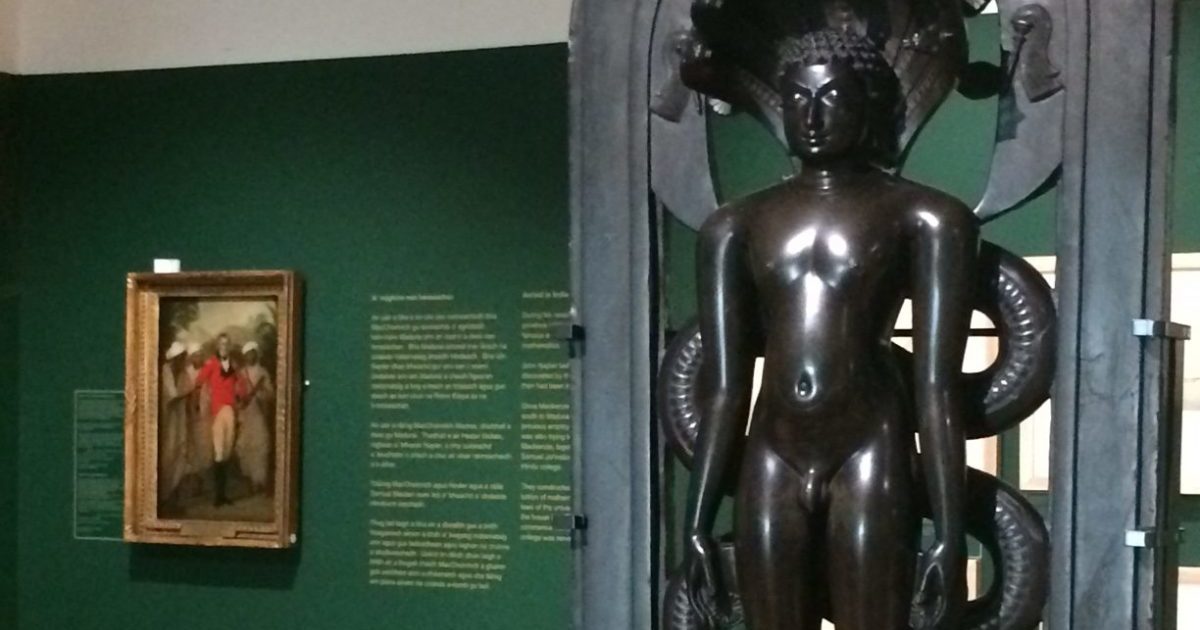In August we launched New Passages, a year-long project commemorating the 70th anniversary of Indian independence and partition, in partnership with An Lanntair in Stornoway and Apeejay Kolkata Literary Festival, with support from the British Council. Writers Abir Mukherjee and Nalini Paul spent a few days on the Isle of Lewis exploring the Mackenzie Collection, a renowned collection of Asian art collected by Stornoway-born Colonel Colin Mackenzie, the first surveyor general of India. The authors will give new voice to the ongoing relationship between Scotland and India as these nations continue to define and redefine their contemporary relationships. Following a visit to Edinburgh in August, they travel on to India before returning to the Book Festival and to Stornoway in 2018.
The following piece is the first response from Abir Mukherjee. The son of Bengali parents, Abir grew up in the West of Scotland and now lives in London. He is the bestselling author of the Sam Wyndham series of novels, including the award-winning Kolkata-based debut, A Rising Man. His second novel, A Necessary Evil, was published in June.
‘British Asians and their Hebridean counterparts aren’t that different. Both seem driven by a need to preserve their own distinct identities in the face of an all pervasive Anglo-Saxon culture…’

It’s a small plane. One of those where the seat can be both an aisle and a window. Buffeted by the winds, it descends and finally breaks through the thick clouds. I stare out of the porthole, and craning my neck, I get my first view of the island that will be my home for the next few days, jutting like a fist out of a harsh black sea.
Within minutes the plane comes in to land. There is no mistaking that this is still Scotland – the landscape is that peculiar mix of verdant green and wet and windswept, but it’s different somehow. Oddly distinct.
It’s my first time on the Isle of Lewis – my first time anywhere in the Outer Hebrides – and I’m anxious to explore this most north-westerly frontier. I’m here for the Purvai Festival – celebrating the links between the people of the Hebrides and the Indian subcontinent, and specifically to see pieces from the Mackenzie Collection – Indian artefacts, sketches and paintings collected by Colonel Colin Mackenzie, a native of Lewis who, the organisers inform me, was the first Surveyor General of India and a ‘collector extraordinaire’. But that is for tomorrow. Today is about acclimatising – getting to know Stornoway and its people.
I take a walk through the town, stopping off at a small café for a bite. My first impressions are uniformly positive. I’ve been in towns on the mainland where the sight of a brown face is enough to elicit wary stares from the locals, but there’s none of that here. Indeed, other than the friendliest of welcomes in the airport, I get hardly a glance directed at me and my self-consciousness starts to dissipate.
In the evening, I walk back to my lodgings. I’m staying in a house on the edge of town, along with some musicians and dancers who’ve travelled up from Birmingham, driving through the night to be here. They’re younger than me – the youngest is not even in his teens, but they’ve chosen to take up the sarangi and the tabla, instruments from their parents’ homeland, and the dancer is an exponent of kathak – a classical Indian dance form. I wonder what drives these people, all British born, to become experts in the instruments and dance of a land far away.
The next day dawns bright and I make my way down to Lews Castle where the items from the Mackenzie collection are being exhibited. As I walk, my thoughts turn to Colin Mackenzie. I wonder what it must have been like, growing up on Lewis in the mid seventeen hundreds. It must have been a hard life. Mackenzie was not wealthy and it was a time of great poverty and upheaval. The Jacobite rebellions had only recently been put down and the horrors of the Highland clearances were in full swing. I wonder too, what Mackenzie must have felt, leaving Stornoway for the voyage to the other side of the world – an emigrant in search of a better life. Did he know he’d never see his home again?
The pieces from his collection are housed in a dedicated room at the museum in Lews Castle – a pristine, white space, whose walls are now covered with some of the myriad maps, sketches, watercolours and inks which Mackenzie collected during his years in India. Around the room are several display cases, filled with smaller items – mainly coins and trinkets, but my attention is immediately grabbed by the object in the centre of the room – a large statue of the god Parsvanatha, with a cowl of seven cobras arching over his head. It is carved out of a single piece of jet black basalt rock and is breathtakingly beautiful. But when I walk round to the back of the statue, my wonderment gives way to anger. On the reverse, in letters which seem foot high, Mackenzie has carved his initials: “C McK 1806”. My reaction surprises me. I’ve never worried much about the appropriation of artefacts from other cultures, but the sight of those letters- so stark, so alien, and carved so casually on the back of this Indian statue – triggers something visceral within me. Something which seems to set my Scottish and Indian halves against each other.
The letters feel like a desecration.
And yet Mackenzie wasn’t some vandal. He seems to have loved India. The plaque beside the statue informs us he’d found the object in a ruined Jain temple. His intention was to save the sculpture from destruction, but the carving of his initials suggests he viewed Indian culture and religions as inferior to his own. It’s rather dispiriting and, I admit, colours my view of the man and his collection. Instead I choose to focus on another, less ostentatious item of the collection. It is a small ink and watercolour sketch of a European woman, possibly Mackenzie’s wife. She is pictured in Indian dress, flanked by natives and smoking a hookah-pipe. To me it is a fusion of Britain and India, and represents a time when the British were happy espousing native customs and weren’t averse to be pictured doing so. As the Raj grew in power, such attitudes would die out, but this sketch is evidence that they did exist at one time. For me it represents everything that the defiled statue does not.
I leave the collection with bittersweet feelings, of both Mackenzie and the practice of expropriating artefacts from their native countries in the name of preservation.
That evening, I attend a recital given by the artists I’m staying with. They are performing with local musicians playing traditional Sottish instruments. Like the painting of woman smoking the hookah, this too is a fusion of the British and the Indian: of Gaelic culture and that of the subcontinent, and it works beautifully. As I listen, it strikes me that maybe these British Asians and their Hebridean counterparts aren’t that different. Both seem driven by a need to preserve their own distinct identities in the face of an all pervasive Anglo-Saxon culture, and while both are minorities seeking to keep alive their own cultural distinctiveness, both are still part of the British whole.
My time on Lewis affected me in ways I’d never expected, and in a few months, my journey in the footsteps of Colin Mackenzie will take me to India. And I have to say, I can’t wait…
Share this Post
